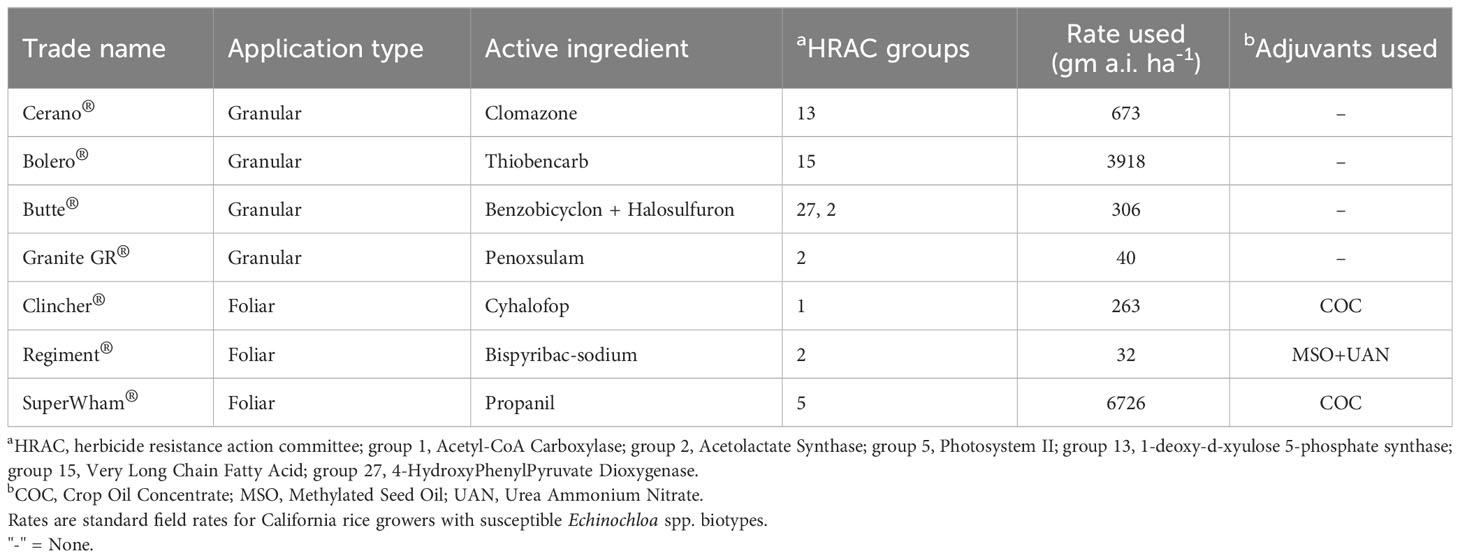Echinochloa spp response to preemergence and postemergence herbicides in California rice (Oryza sativa L.)
- 1Plant Science Department, University of California Davis, Davis, CA, United States
- 2University of California Cooperative Extension Sutter-Yuba, Yuba City, CA, United States
Historically, herbicides were used for Echinochloa spp control in California rice production which led to the selection of herbicide-resistant biotypes. Field surveys were conducted across the seven major rice-growing counties in 2020 and Echinochloa spp samples including barnyardgrass (Echinochloa crus-galli (L.) P.Beauv.), junglerice (Echinochloa colona (L.) Link), late watergrass (Echinochloa oryzicola (Vasinger) Vasinger) and coast cockspur (Echinochloa walteri (Pursh) Heller) were collected. Greenhouse experiments were carried out to determine their suspected resistance to common preemergence and postemergence rice herbicides used in California in Fall and Winter of 2021. A total of 62 and 63 samples were characterized for suspected resistance to four preemergence granular and three postemergence foliar-applied herbicides, respectively. When granular herbicides were evaluated, samples suspected of resistance in Winter were a subset of samples that were suspected of resistance in Fall. Results indicate >90% of Echinochloa spp samples were resistant to thiobencarb, benzobicyclon + halosulfuron and penoxsulam when combined across species and counties. Cross-resistance between benzobicyclon + halosulfuron and penoxsulam was observed in >90% of the samples when combined across species and counties. Suspected clomazone resistance was observed in <75% of the samples when combined across species and counties. Suspected resistance to cyhalofop and propanil was observed in <50% of the samples when averaged across both runs. Multiple-resistance to foliar herbicides ranged from 48-60% of the samples across species and experimental runs. These results indicate the necessity for rotating herbicides during alternate cropping seasons and emphasizing integrating non-chemical strategies for Echinochloa spp control in California rice production.
1 Introduction
Rice is one of the top ten economically valuable agricultural commodities in California with more than 50% of production exported to South-East Asian countries and valued at US$1.17 billion in 2021 (California Department of Food and Agriculture, 2021). Rice was planted on 407,000 acres in California (Economics, Statistics and Market Information System, 2022a) with approximately 95% of total rice acres planted in northern Central Valley region in 2021 (National Agricultural Statistics Service, 2023). Though California accounted for only 16% of total US rice acreage in 2022, it ranks highest in productivity in the country with more than 9.8 metric tons ha-1 (Economics, Statistics and Market Information System, 2022b). Effective weed management is critical for consistent and successful rice production. Weed species in California rice production systems are diverse, consisting of grasses, broadleaf weeds, and sedges that can survive in aerobic or anaerobic conditions or both (Heap, 2023). Grasses are harder to manage because of the narrow selectivity between weeds and the crop and cause the most yield losses out of grasses, sedges, and broadleaves in rice (Brim-DeForest et al., 2017).
Echinochloa spp like Echinochloa crus-galli (L.) P. Beauv. (barnyardgrass), Echinochloa colona (L.) Link (junglerice), Echinochloa oryzoides (Ard.) Fritsch (early watergrass) and Echinochloa oryzicola (Vasinger) Vasinger (late watergrass) are reported as the most common and troublesome weeds in transplanted and direct-seeded rice systems in California (Van Wychen, 2019). Echinochloa spp are also found worldwide in most rice-growing regions of the world and are considered one of the most difficult weed complexes to control (Kraehmer et al, 2016). In California rice systems, pregerminated rice seed is direct-seeded onto the flooded field by airplane, and a flooding depth of 10 to 15 cm is maintained throughout the growing season (Kanapeckas et al., 2018). Continuous flooding provides partial control of watergrass species which requires a follow-up with water-applied and foliar herbicides for season-long control (Fischer et al., 2000a). Clomazone is a water-applied herbicide that has good activity on grasses and is widely used right after direct seeding. Cyhalofop, bispyribac-sodium, and propanil are the only registered foliar herbicides that have grass activity. Thiobencarb, penoxsulam, benzobicyclon + halosulfuron are also used as part of the herbicide programs which have both grass and sedge activity (UC-ANR, 2023). However, repeated use of herbicides in monoculture and continuous flood irrigation imposed heavy selection pressure on weed species in California rice systems (Brim-DeForest et al., 2017; Driver et al., 2020). Watergrass species resistant to the majority of water-applied and foliar applied herbicides were reported previously in California threatening rice production (Fischer et al., 2000b; Yasuor et al., 2008; Yasuor et al., 2009). However, limited information is available about the current status of herbicide resistance and its distribution in different Echinochloa spp in California rice production. Recent reports of uncontrolled grasses, as well as possible new species precipitated renewed research on this genus. Therefore, a field level survey was conducted across the rice growing counties to confirm and characterize the resistance in Echinochloa spp to commonly used herbicides in California rice production.
2 Materials and methods
Field surveys were conducted during August and September of 2020 and seed samples of different Echinochloa spp were collected with the goal of understanding their sensitivity/suspected resistance to major herbicides used in California rice production. Samples were collected by researchers, to ensure that samples were unmixed. A total of 64 samples consisting of barnyardgrass, junglerice, late watergrass, and coast cockspur (Echinochloa walteri (Pursh) Heller) were collected across seven rice counties in Northern Sacramento Valley, California (Table 1 and Figure 1). Samples were not randomly collected from across the valley, but were collected from fields that had plants that had produced seed at the end of the growing season, where herbicides had been applied. Samples were collected from individual fields by random sampling across each field, with each sample representing a single species with multiple individual plants (a population). The species were keyed using the Flora of North America North of Mexico (Flora of North America Editorial Committee, 1993).

Table 1 Echinochloa spp. samples collected from different rice counties of Northern California in 2020.
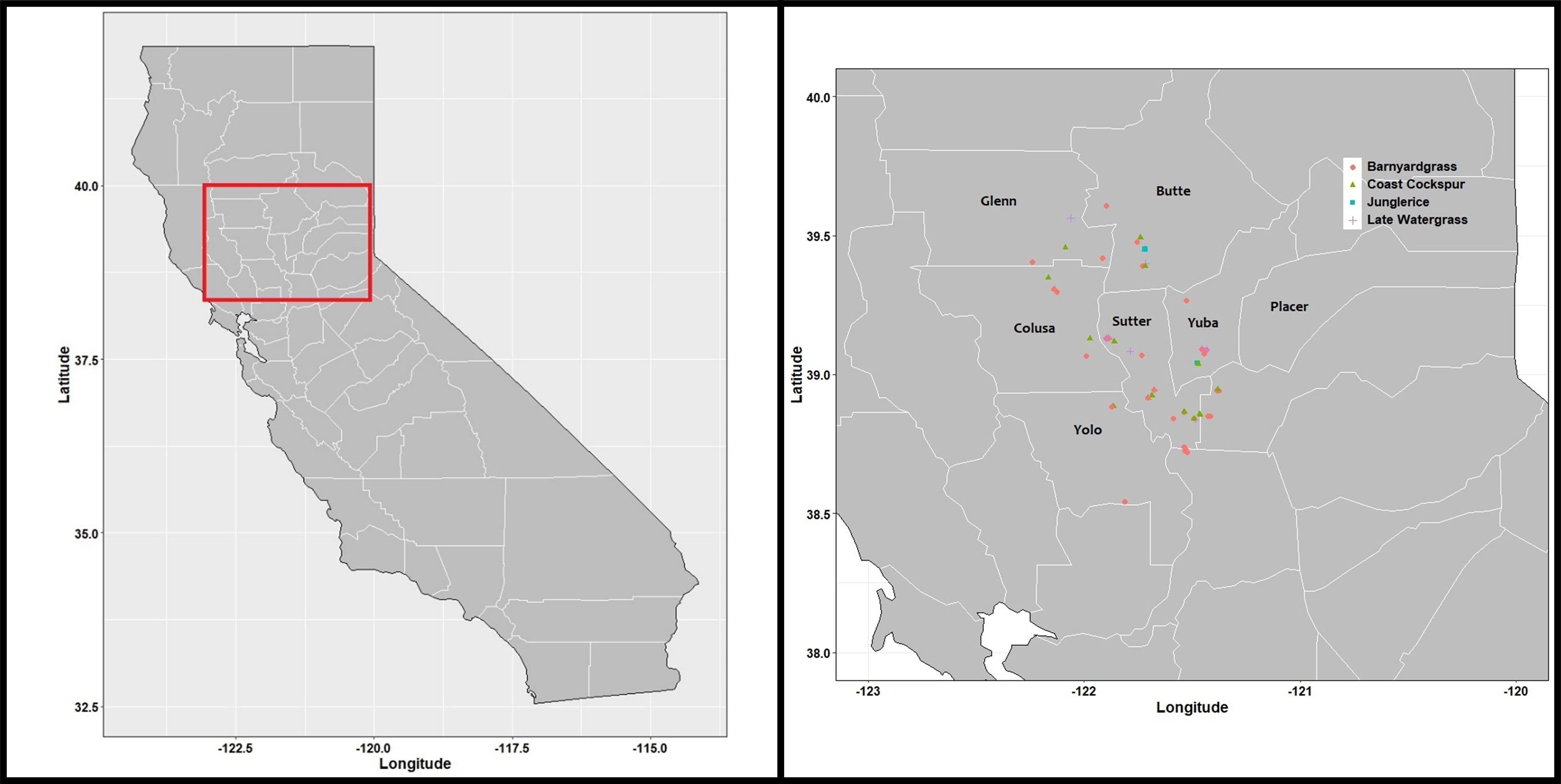
Figure 1 Collection sites of different Echinochloa samples used in the experiment. Field surveys were conducted in all rice-growing counties highlighted in the picture (left) and different species collected (right).
Two independent greenhouse experiments were conducted in the fall (August) and winter (December) of 2021 to evaluate the efficacy of various granular (into the water-applied) and foliar-applied herbicides commonly used in California rice (Table 2). A population of late watergrass (E. oryzicola) collected from organic rice fields was added to the experiments as a control. No known susceptible controls were available for barnyardgrass, coast cockspur, or junglerice. Greenhouse experiments were conducted at the California Rice Experiment Station (CRES) greenhouse in Biggs, California (39.464784 N, -121.741464 W).
The greenhouse was maintained at 33/17 ± 5C day/night temperature and 33%/84% ± 10% day/night relative humidity and ambient light and day length. The experiment was set up as a randomized complete block design with each herbicide treatment replicated three times per sample, with two different replications in time (fall and winter), with at least 15 plants per sample per replication in time. Dormancy of the seed samples was broken by wet-chilling in the fridge for approximately two weeks before planting. Later, seeds were pre-germinated in plastic containers in an incubator maintained at 30 C for at least two days. Light was turned on for 18-hour periods. At least five seedlings (with radicle emerged) per sample were transferred into pots containing Esquon clay soil with 20% sand, 33% silt, 47% clay, and 2.3% organic matter content (collected from a rice field at the California Rice Experiment Station in Biggs, CA).
Pots (6.3 cm3) were placed in benches (29 cm deep) and irrigation water was allowed to sub up from below the pots to saturation before planting, and then was increased at flooding to a depth of 10 cm above the soil surface. Preemergence water-applied herbicide applications were made on the day of seeding, onto the surface of bins that were flooded to 10 cm above the soil surface of the pots where the pre-germinated seeds were planted. Foliar applied herbicides were applied with the label-recommended surfactants to the foliage when the seedlings were 1.5-2 leaf stage. All postemergence foliar herbicide applications were made using a cabinet track sprayer with an 8001-EVS nozzle delivering 375 liters of spray solution per hectare at a pressure of approximately 138 kPa. After foliar herbicide applications, a flood was applied at 10 cm above the soil surface at 48 hours. All water-applied and foliar herbicides were applied at standard field rates used in California rice (Table 2).
3 Data collection and analysis
Treatment effects were evaluated at 21 days after herbicide treatment (DAT). Number of living plants per pot was counted, and fresh biomass per pot was recorded by cutting plants at the soil surface. Dry biomass was measured after drying the fresh-weight samples down to a constant weight. Percent control was calculated as the difference between the number of living plants in the pots before and at 21 days after herbicide application as a percentage. Dry biomass control was calculated as the difference between dry weight in herbicide-applied pots compared to untreated control pots as a percentage. Samples were classified as ‘suspected resistant’ to an herbicide if the average percent dry biomass control was less than that of the susceptible control.
4 Results and discussion
4.1 Echinochloa field sampling and species composition
A total of 64 Echinochloa samples were randomly collected from Butte (8), Colusa (6), Glenn (5), Sutter (23), Placer (9), Yuba (10), and Yolo (3) counties. Based on the phenotypic characteristics, a total of 31 of the total 64 samples were classified as barnyardgrass, 21 were classified as coast cockspur and 10 were classified as late watergrass. Only 2 samples collected from Butte and Yuba counties were classified as junglerice (Table 1). Approximately, 70% of the barnyardgrass, late watergrass samples, and >60% of coast cockspur samples were collected from just Placer, Sutter, and Yuba counties (Table 1). Historically, early watergrass, late watergrass, and barnyardgrass are the primary grass weed species found in California rice systems (Fischer et al., 2000a; Brim-DeForest et al., 2017). Sample size for junglerice in this study was small and similar observations were recorded in a rice weed survey conducted in California in 2019 (Brim-DeForest, 2020). Coast cockspur accounted for approximately 34% of total samples across the seven counties. Coast cockspur has a history of high presence in the southern US rice belt but this is perhaps the first time it has been reported in California rice-producing regions (Brim-DeForest, 2018). Therefore, it is important to constantly monitor for new species because some of these species may be tolerant to many of our rice herbicides. Accurate identification and continuous monitoring of weeds’ response to various herbicides at the county level is necessary for developing best management practices for sustainable rice production in this region.
4.2 Herbicide resistance screening
A total of 62 samples were tested for suspected resistance to granular herbicides clomazone, thiobencarb, premix of benzobicyclon + halosulfuron and penoxsulam, and 63 samples were tested for suspected resistance to foliar herbicides cyhalofop, bispyribac-sodium, and propanil. A significant difference was observed in Echinochloa spp response to granular and foliar herbicides between the two independent runs. Therefore, data was presented separately by individual run.
4.2.1 Granular formulated herbicides
High proportions of barnyardgrass, late watergrass and coast cockspur samples (93-100%) were suspected resistant to thiobencarb, benzobicyclon + halosulfuron and penoxsulam in fall (Table 3). Compared to other herbicides, Echinochloa spp response to clomazone varied drastically between the two runs with 70-80% barnyardgrass, late watergrass and coast cockspur samples suspected resistant in fall while only 20% or less were suspected resistant in winter (Table 3). Though data were presented separately by individual runs, we observed that the samples suspected of resistance in winter were a subset of same samples that were suspected resistant in fall for all species. High temperature tends to reduce herbicide efficacy in Echinochloa spp. and higher degree days during fall compared to winter may have contributed to coming out of herbicide injury and putting up higher biomass, consequently leading to higher proportion of suspected resistant samples (Nguyen et al., 2016; Refatti et al., 2019). None of the junglerice populations were suspected resistant to clomazone and thiobencarb in fall while only 50% of them were suspected resistant in winter (Table 3). In fall, more than 90% of the samples in all the counties were suspected resistant to thiobencarb, benzobicyclon + halosulfuron and penoxsulam whereas only 73% of the samples were suspected resistant to clomazone (Table 4) indicating clomazone can be an effective option for Echinochloa spp control in rice. Thiobencarb and ALS resistance was reported in Echinochloa spp in California rice as early as 1998 due to their long use history in irrigated rice systems (Osuna et al., 2002). Barnyardgrass samples showed greater susceptibility to all the herbicides during winter compared to late watergrass and coast cockspur (Table 3). For Echinochloa spp samples evaluated in fall, more than 90% of the samples were suspected resistant to multiple MOAs and cross-resistance between the ALS-inhibiting herbicide formulations benzobicyclon + halosulfuron and penoxsulam (Table 4). These results indicate the widespread prevalence of cross-resistance between ALS-inhibiting herbicides and multiple resistance to other granular herbicides across the major rice-growing counties in California and agree with Becerra-Alvarez et al., 2023.

Table 3 Proportion of Echinochloa spp. samples suspected resistant to granular formulated herbicides across rice growing counties in California in comparison to a susceptible late watergrass (Echinochloa oryzicola) population.

Table 4 County-level proportions of Echinochloa spp. samples suspected resistant to granular and foliar herbicides in comparison to a susceptible late watergrass population.
None of the Echinochloa samples were resistant to clomazone or thiobencarb or benzobicyclon + halosulfuron alone when combinedly evaluated for multiple resistance in fall (Figure 2A). A suspected two-way and three-way resistance between thiobencarb, penoxsulam and benzobicyclon + halosulfuron was observed in up to 18% of the samples and more than 70% of all Echinochloa spp samples (45) were suspected resistant to all four granular herbicides evaluated in this study (Figure 2A). Similar results were observed by Becerra-Alvarez et al., 2023 who observed >50% of barnyardgrass and late watergrass samples resistant to at least 3 MOAs, mostly thiobencarb, penoxsulam and benzobicyclon + halosulfuron. More than 85% of individual barnyardgrass, late watergrass, and coast cockspur samples were suspected multiple resistant to at least 3 herbicide MOAs evaluated in this study in fall (Table 5). Even though Echinochloa samples were more susceptible in winter, the majority of them were suspected of multiple 2 or more MOAs (Table 5). Clomazone, thiobencarb, penoxsulam, and benzobicyclon + halosulfuron four-way suspected resistance was observed in 66% of barnyardgrass samples (Figure 2B), 80% of late watergrass and coast cockspur samples (Figures 2C, D). Resistance to clomazone, cyhalofop, bispyribac-sodium, penoxsulam was also previously reported in Echinochloa spp in California (Osuna et al., 2002; Tsuji et al., 2003; Yasuor et al., 2009). These results are an indicator of significant threat to controlling Echinochloa spp using the common granular herbicide and the need to use alternate cultural practices, herbicide rotation, or fallow or rotate out of rice into another crop if possible. Care should be taken not to create greater selection pressure for herbicide resistance.
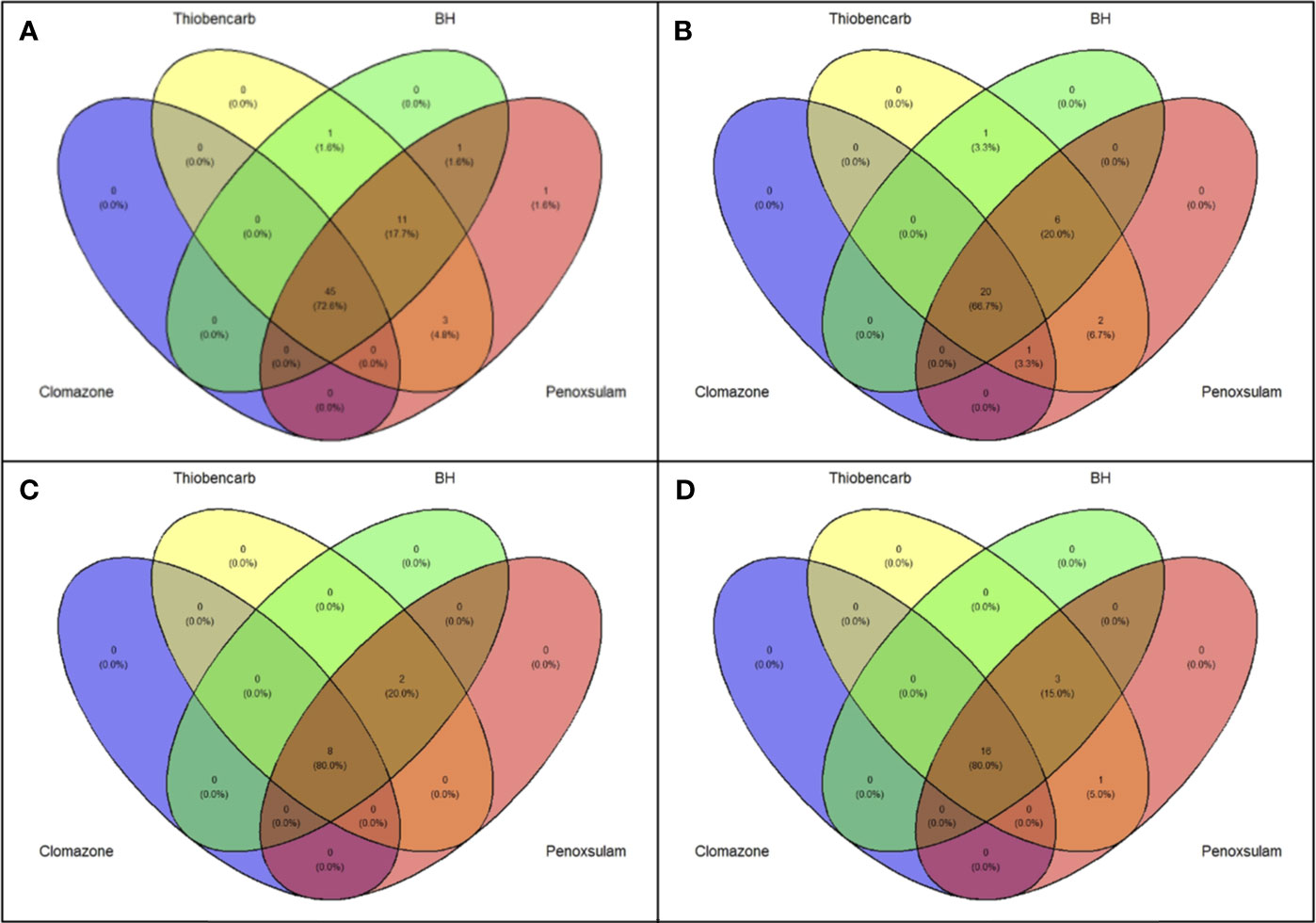
Figure 2 Venn diagrams showing Echinochloa samples [all samples combined (A) barnyardgrass (B) late watergrass (C) coast cockspur (D)] suspected resistant to thiobencarb, benzobicyclon + halosulfuron, clomazone and penoxsulam tested in this study tested in Fall 2021 at Biggs, CA. Each oval represents one herbicide and overlapping ovals indicate that the accessions within a given group are multiple resistant to the respective herbicides.
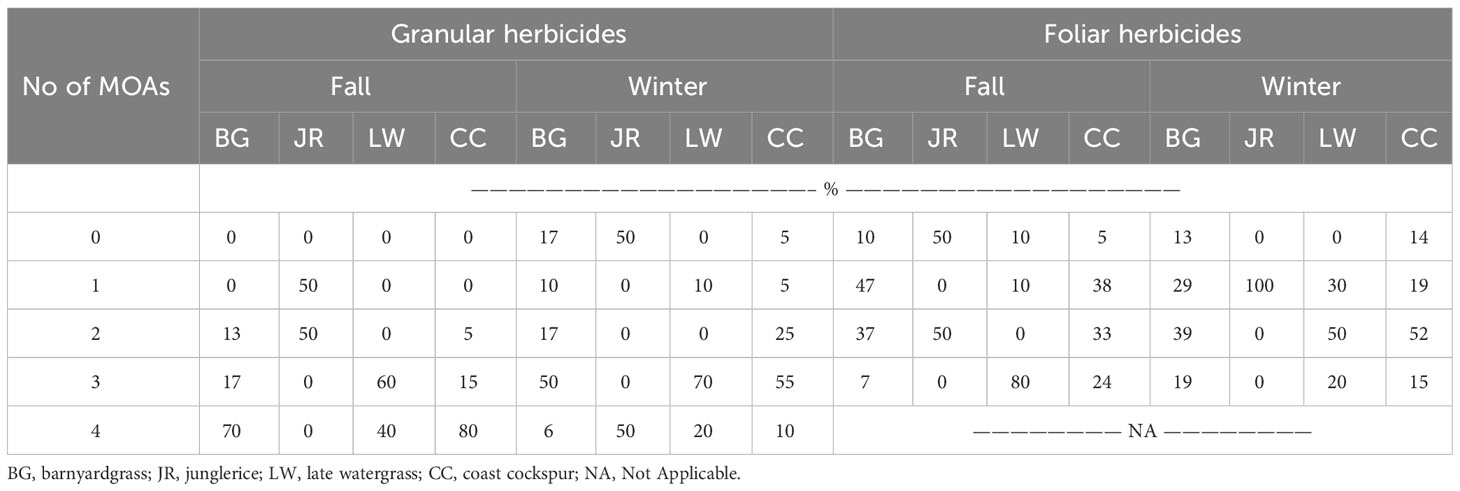
Table 5 Proportion of samples showing different suspected resistance profile categories collected from California rice fields in 2020.
4.2.2 Foliar herbicides
Less than 30% of barnyardgrass and coast cockspur samples were suspected resistant to propanil in both experimental runs (Table 3). None of the junglerice samples were suspected resistant to cyhalofop in both experimental runs (Table 3). While more than 80% of late watergrass samples were suspected resistant to bispyribac-sodium and propanil in fall, only 60% and, 30% were suspected resistant in winter to those respective herbicides (Table 3). Barnyardgrass sensitivity to cyhalofop decreased in winter (Table 3), contrary to results by Refatti et al., 2019. Suspected resistance to multiple MOAs was observed in 70-80% late watergrass samples, 55-70% coast cockspur samples, 30-60% barnyardgrass samples and 0-50% in junglerice samples (Table 3). Suspected multiple resistance was observed in >50% of the samples in all the counties across the two experiments (Table 4). More than 45% of barnyardgrass samples, 70% of late watergrass samples and 50% of coast cockspur samples were suspected resistant to at least 2 MOAs across two runs (Table 5).
In fall, 68% of the barnyardgrass samples were suspected resistant to cyhalofop, bispyribac and propanil and 19% of the samples were suspected resistant to bispyribac and propanil (Figure 3A). In Winter, only 23% of the samples were suspected resistant to cyhalofop, bispyribac and propanil while 39% of the samples were suspected resistant to cyhalofop and bispyribac and 19% of the samples were suspected resistant to cyhalofop alone (Figure 3D). In fall, 88% of the late watergrass samples were suspected resistant to cyhalofop, bispyribac and propanil (Figure 3B). In winter, only 20% of the samples were suspected resistant to cyhalofop, bispyribac and propanil while 40% of the samples were suspected resistant to cyhalofop and bispyribac and 30% of the samples were suspected resistant to cyhalofop alone (Figure 3E). In fall, 25% of the coast cockspur samples were suspected resistant to cyhalofop, bispyribac and propanil while 40% of the samples were resistant to cyhalofop and bispyribac and 20% of the samples were resistant to bispyribac alone (Figure 3C). In winter, only 17% of the samples were suspected resistant to cyhalofop, bispyribac and propanil while 50% of the samples were suspected resistant to cyhalofop and bispyribac and 17% of the samples were suspected resistant to cyhalofop alone (Figure 3F). These results indicate a drastic reduction in propanil resistance from fall to winter in barnyardgrass, late watergrass and coast cockspur samples. Unlike southern US states where propanil resistance is widespread in rice (Rouse et al., 2018), propanil resistance was first reported in small flower umbrella sedge in 2013 (Pedroso et al., 2013). Results from this study indicate propanil can still be an effective option for Echinochloa spp control in California rice. Increased evidence for suspected cyhalofop resistance could be attributed to the long history of its use in California rice along with other ALS-inhibiting herbicides.
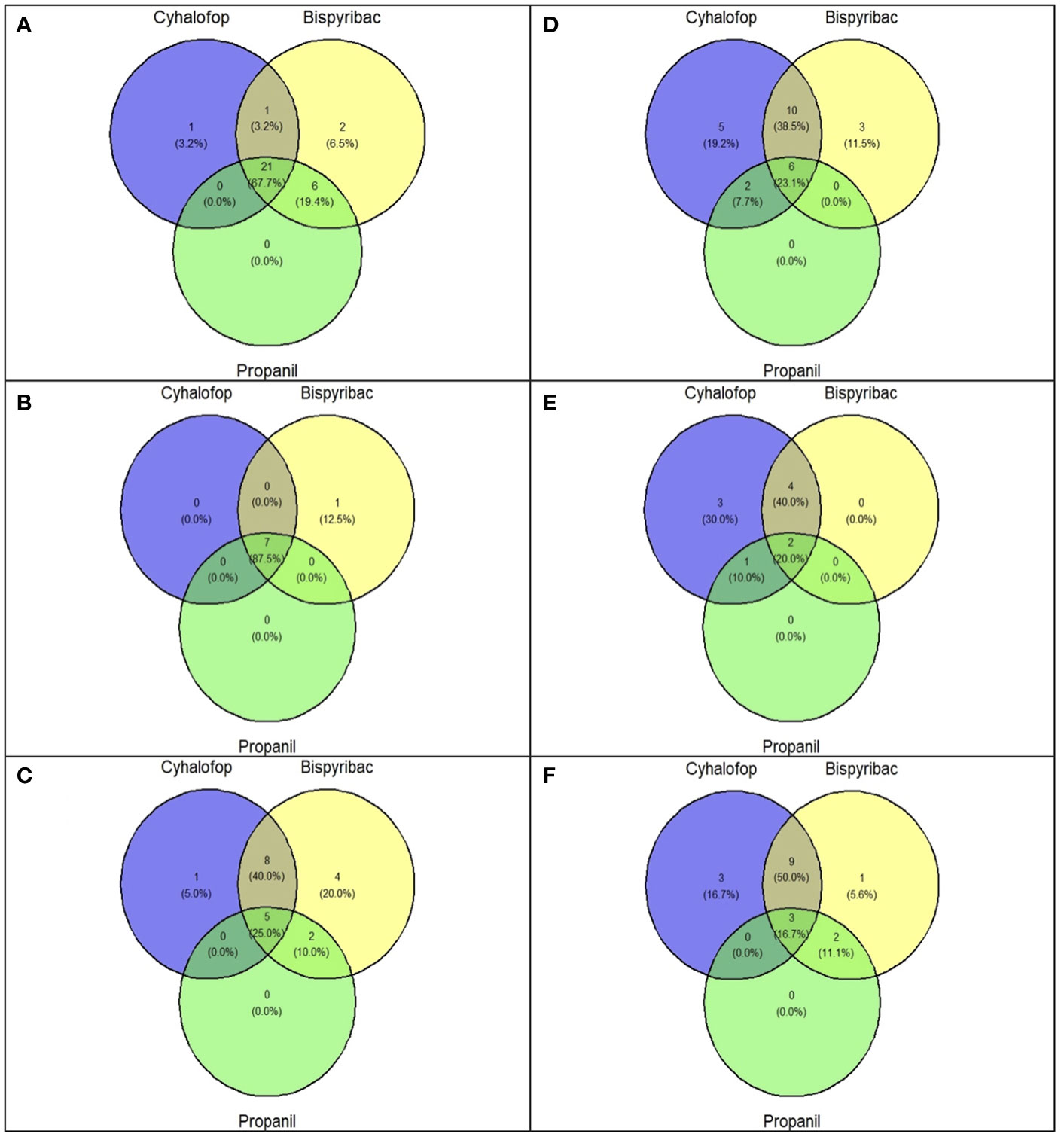
Figure 3 Venn diagrams showing barnyardgrass, late watergrass and coast cockspur samples suspected resistant to cyhalofop, bispyribac-sodium and propanil tested in Fall [(A–C) respectively] and Winter [(D–F) respectively] of 2021 at Biggs, CA. Each oval represents one herbicide and overlapping ovals indicate that the accessions within a given group are multiple resistant to the respective herbicides.
Herbicide metabolism, a non-target site resistance, has been the primary mechanism in Echinochloa spp for bispyribac sodium (Fischer et al., 2000b) propanil (Hoagland et al., 2004) and clomazone (Yasuor et al., 2008). However, previous studies indicate multiple resistance could evolve by both target-site or non-target site or a combination of both in Echinochloa spp (Liu et al., 2019; Rouse et al., 2019).
Understanding the distribution of herbicide resistance provides valuable insights into designing effective control measures. In this study, we attempted to characterize the resistance patterns in major Echinochloa spp that are commonly observed across different rice-growing counties in California. Samples were characterized for suspected resistance to up to six widely used herbicide MOAs in California rice and presented at the county level. Multiple resistance is mostly evolved up to two and three MOAs in most of the counties, and samples from all counties were suspected of multiple resistance (granular herbicides). Therefore, using different herbicide MOAs during alternate growing seasons and integrating chemical and non-chemical strategies could slow down the evolution of resistance before it becomes widespread in those counties. For future research extensive sampling could provide a finer understanding of the distribution of herbicide resistance across these counties and look at the genetic or physiological mechanisms underlying mechanisms that would allow Echinochloa spp. to adapt to diverse herbicide applications.
Data availability statement
The raw data supporting the conclusions of this article will be made available by the authors, without undue reservation.
Author contributions
RV: Writing – review & editing, Formal analysis, Software, Validation, Visualization, Writing – original draft. TG: Data curation, Formal analysis, Investigation, Writing – original draft. TC: Data curation, Investigation, Writing – review & editing. WB-D: Writing – review & editing, Conceptualization, Funding acquisition, Investigation, Methodology, Project administration, Resources, Supervision.
Funding
The author(s) declare financial support was received for the research, authorship, and/or publication of this article. The California Rice Research Board (RR23-4) provided funding.
Acknowledgments
The California Rice Experiment Station provided greenhouse space. Amelia Zepeda, Kayla Minehan, Marco Giron, and Taylor Richardson assisted in data collection.
Conflict of interest
The authors declare that the research was conducted in the absence of any commercial or financial relationships that could be construed as a potential conflict of interest.
Publisher’s note
All claims expressed in this article are solely those of the authors and do not necessarily represent those of their affiliated organizations, or those of the publisher, the editors and the reviewers. Any product that may be evaluated in this article, or claim that may be made by its manufacturer, is not guaranteed or endorsed by the publisher.
References
Becerra-Alvarez A., Godar A. S., Ceseski A. R., Al-Khatib K. (2023). Herbicide resistance management in rice: annual field survey of California rice weeds helps establish a weed management decision framework. Outlooks Pest Manage. 34, 51–57. doi: 10.1564/v34_apr_02
Brim-DeForest W. (2018)Be on the lookout for two new watergrass relatives. In: Rice Farming. Available at: https://www.ricefarming.com/departments/specialists-speaking/be-on-the-lookout-for-two-new-watergrass-relatives/ (Accessed July 23, 2023).
Brim-DeForest W. (2020) California Rice Weeds Survey 2019. Available at: https://sites.google.com/ucdavis.edu/californiariceweedssurvey2019 (Accessed October 10, 2023).
Brim-DeForest W. B., Al-Khatib K., Fischer A. J. (2017). Predicting yield losses in rice mixed-weed species infestations in California. Weed Sci. 65, 61–72. doi: 10.1614/WS-D-16-00079.1
California Department of Food and Agriculture, U (2021)California agricultural statistics review 2021-2022. In: California Agricultural Production Statistics. Available at: https://www.cdfa.ca.gov/Statistics/ (Accessed May 28, 2023).
Driver K. E., Al-Khatib K., Godar A. (2020). Bearded sprangletop (Diplachne fusca ssp. fascicularis) flooding tolerance in California rice. Weed Technol. 34, 193–196. doi: 10.1017/wet.2019.86
Economics, Statistics and Market Information System, U (2022a) Acreage. Acreage. Available at: https://usda.library.cornell.edu/concern/publications/j098zb09z (Accessed May 28, 2023).
Economics, Statistics and Market Information System, U (2022b). “Crop values 2022 summary,” in Crop Values Annual Summary. Available at: https://usda.library.cornell.edu/concern/publications/k35694332.
Fischer A. J., Ateh C. M., Bayer D. E., Hill J. E. (2000a). Herbicide-resistant Echinochloa oryzoides and E. phyllopogon in California Oryza sativa fields. Weed Sci. 48, 225–230. doi: 10.1614/0043-1745(2000)048[0225:HREOAE]2.0.CO;2
Fischer A. J., Bayer D. E., Carriere M. D., Ateh C. M., Yim K.-O. (2000b). Mechanisms of resistance to bispyribac-sodium in an echinochloa phyllopogon accession. Pesticide Biochem. Physiol. 68, 156–165. doi: 10.1006/pest.2000.2511
Flora of North America Editorial Committee (1993) Flora of North America North of Mexico. Available at: http://floranorthamerica.org/Fumaria (Accessed December 2, 2023).
Heap I. (2023) The International Herbicide-Resistant Weed Database. Available at: http://www.weedscience.org/.
Hoagland R. E., Norsworthy J. K., Carey F., Talbert R. E. (2004). Metabolically based resistance to the herbicide propanil in Echinochloa species. Weed Sci. 52, 475–486. doi: 10.1614/WS-03-039R
Kanapeckas K. L., Tseng T.-M., Vigueira C. C., Ortiz A., Bridges W. C., Burgos N. R., et al. (2018). Contrasting patterns of variation in weedy traits and unique crop features in divergent populations of US weedy rice (Oryza sativa sp.) in Arkansas and California. Pest Manage. Sci. 74, 1404–1415. doi: 10.1002/ps.4820
Kraehmer H., Jabran K., Husrev Mennan H., Chauhan B. S. (2016). Global distribution of rice weeds – A review. Crop Prot. 80, 73–86. doi: 10.1016/j.cropro.2015.10.027
Liu J., Fang J., He Z., Li J., Dong L. (2019). Target site–based resistance to penoxsulam in late watergrass (Echinochloa phyllopogon) from China. Weed Sci. 67, 380–388. doi: 10.1017/wsc.2019.14
National Agricultural Statistics Service, U. S. D. @ of A (2023) California Rice County Estimates. Available at: https://www.nass.usda.gov/Statistics_by_State/California/Publications/County_Estimates/index.php.
Nguyen T. H., Malone J. M., Boutsalis P., Shirley N., Preston C. (2016). Temperature influences the level of glyphosate resistance in barnyardgrass (Echinochloa colona). Pest Manage. Sci. 72, 1031–1039. doi: 10.1002/ps.4085
Osuna M. D., Vidotto F., Fischer A. J., Bayer D. E., De Prado R., Ferrero A. (2002). Cross-resistance to bispyribac-sodium and bensulfuron-methyl in Echinochloa phyllopogon and Cyperus difformis. Pesticide Biochem. Physiol. 73, 9–17. doi: 10.1016/S0048-3575(02)00010-X
Pedroso R. M., Boddy L. G., Fischer A. (2013). Propanil resistance in smallflower umbrella sedge (Cyperus difformis L.): a new challenge to rice growers in California. Available at: http://wssaabstracts.com/public/17/proceedings.html (Accessed January 20, 2024).
Refatti J. P., de Avila L. A., Camargo E. R., Ziska L. H., Oliveira C., Salas-Perez R., et al. (2019). High [CO2] and temperature increase resistance to cyhalofop-butyl in multiple-resistant echinochloa colona. Front. Plant Sci. 10. doi: 10.3389/fpls.2019.00529
Rouse C. E., Roma-Burgos N., Martins B. A. B. (2019). Physiological assessment of non–target site restistance in multiple-resistant junglerice (Echinochloa colona). Weed Sci. 67, 622–632. doi: 10.1017/wsc.2019.52
Rouse C. E., Roma-Burgos N., Norsworthy J. K., Tseng T.-M., Starkey C. E., Scott R. C. (2018). Echinochloa resistance to herbicides continues to increase in Arkansas rice fields. Weed Technol. 32, 34–44. doi: 10.1017/wet.2017.82
Tsuji R., Fischer A. J., Yoshino M., Roel A., Hill J. E., Yamasue Y. (2003). Herbicide-resistant late watergrass (Echinochloa phyllopogon): similarity in morphological and amplified fragment length polymorphism traits. Weed Sci. 51, 740–747. doi: 10.1614/P2002-143
UC-ANR (2023)California rice weed herbicide susceptibility chart. In: Susceptibility Chart. Available at: https://agronomy-rice.ucdavis.edu/Guidelines/Weeds (Accessed September 25, 2023).
Van Wychen L. (2019). 2019 Survey of the Most Common and Troublesome Weeds in Broadleaf Crops, Fruits & Vegetables in the United States and Canada. Weed Science Society of America National Weed Survey Dataset. Available at: https://wssa.net/wp-content/uploads/2019-Weed-Survey_broadleaf-crops.xlsx (Accessed January 20, 2024).
Yasuor H., Osuna M. D., Ortiz A., Saldaín N. E., Eckert J. W., Fischer A. J. (2009). Mechanism of resistance to penoxsulam in late watergrass [Echinochloa phyllopogon (Stapf) koss.]. J. Agric. Food Chem. 57, 3653–3660. doi: 10.1021/jf8039999
Keywords: late watergrass, barnyardgrass, coast cockspur, herbicide resistance, rice, Echinochloa spp
Citation: Vulchi R, Guan T, Clark T and Brim-DeForest W (2024) Echinochloa spp response to preemergence and postemergence herbicides in California rice (Oryza sativa L.). Front. Agron. 6:1349008. doi: 10.3389/fagro.2024.1349008
Received: 04 December 2023; Accepted: 12 January 2024;
Published: 30 January 2024.
Edited by:
Simerjeet Kaur, Punjab Agricultural University, IndiaReviewed by:
Hossein Ghanizadeh, Massey University, New ZealandAhmet Uludag, Çanakkale Onsekiz Mart University, Türkiye
Copyright © 2024 Vulchi, Guan, Clark and Brim-DeForest. This is an open-access article distributed under the terms of the Creative Commons Attribution License (CC BY). The use, distribution or reproduction in other forums is permitted, provided the original author(s) and the copyright owner(s) are credited and that the original publication in this journal is cited, in accordance with accepted academic practice. No use, distribution or reproduction is permitted which does not comply with these terms.
*Correspondence: Whitney Brim-DeForest, wbrimdeforest@ucanr.edu
 Rohith Vulchi
Rohith Vulchi Taiyu Guan
Taiyu Guan Troy Clark
Troy Clark Whitney Brim-DeForest
Whitney Brim-DeForest